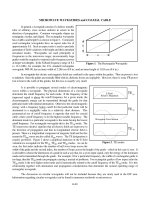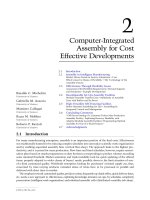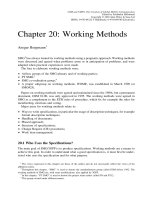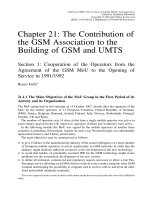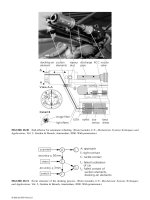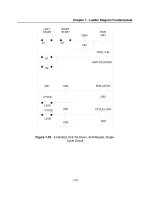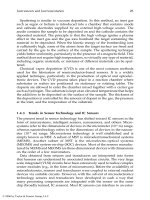Math Puzzles and Brainteasers, Grades 3-5: Over 300 Puzzles that Teach Math and Problem-Solving Skills pptx
Bạn đang xem bản rút gọn của tài liệu. Xem và tải ngay bản đầy đủ của tài liệu tại đây (6.96 MB, 254 trang )
ftoc.indd 6 7/13/09 5:11:02 PM
Praise for Math Puzzles and Brainteasers
Terry Stickels combines his masterful ability to create diverse, challenging
and just plain fun puzzles with a wide range of math concepts, in a playful
way that encourages the solver to discover their own unique methods of
finding solutions.
—David Kalvitis, author of The Greatest
Dot-to-Dot Books in the World
Logical, numerical, visual-spatial, and creative thinking problems can all
be found within these covers, embracing a wide spectrum of thinking
skills for developing minds. Terry Stickels also encourages indulgence
in mathematical play, which for young students is an indispensable
component of motivated and successful problem solving.
—Barry R. Clarke, Mind Gym compiler,
The Daily Telegraph (UK)
Even kids who are not math nerds will enjoy this book. Stickels hits the
perfect mix of brainteasers: They’re challenging while still managing to be
great fun at the same time!
—Casey Shaw, Creative Director, USA WEEKEND magazine
Terry Stickels is clearly this country’s Puzzle Laureate. He has concocted
a delightful and challenging volume of brainteasers that belong in every
math teacher’s library. Focused specifically on grades 3–5 and grades 6–8,
these puzzles both educate and sharpen children’s critical thinking skills. As
an award-winning puzzle constructor myself, I am always in awe of what
Terry comes up with.
—Sam Bellotto Jr., Crossdown
ffirs.indd 1 7/9/09 12:06:47 PM
Jossey-Bass Teacher provides educators with practical knowledge and
tools to create a positive and lifelong impact on student learning.
We offer classroom-tested and research-based teaching resources for a
variety of grade levels and subject areas. Whether you are an aspiring,
new, or veteran teacher, we want to help you make every teaching
day your best.
From ready-to-use classroom activities to the latest teaching
framework, our value-packed books provide insightful, practical, and
comprehensive materials on the topics that matter most to K–12
teachers. We hope to become your trusted source for the best ideas
from the most experienced and respected experts in the field.
ffirs.indd 2 7/9/09 12:06:47 PM
Over 300 Puzzles that Teach
Math and Problem-Solving Skills
Terry Stickels
ffirs.indd 3 7/9/09 12:06:47 PM
Published by Jossey-Bass
A Wiley Imprint
989 Market Street, San Francisco, CA 94103-1741—www.josseybass.com
No part of this publication may be reproduced, stored in a retrieval system, or transmitted in any form or by
any means, electronic, mechanical, photocopying, recording, scanning, or otherwise, except as permitted under
Section 107 or 108 of the 1976 United States Copyright Act, without either the prior written permission of
the publisher, or authorization through payment of the appropriate per-copy fee to the Copyright Clearance
Center, Inc., 222 Rosewood Drive, Danvers, MA 01923, 978-750-8400, fax 978-646-8600, or on the Web at www.
copyright.com. Requests to the publisher for permission should be addressed to the Permissions Department,
John Wiley & Sons, Inc., 111 River Street, Hoboken, NJ 07030, 201-748-6011, fax 201-748-6008, or online at
www.wiley.com/go/permissions.
Permission is given for individual classroom teachers to reproduce the pages and illustrations for classroom use.
Reproduction of these materials for an entire school system is strictly forbidden.
Readers should be aware that Internet Web sites offered as citations and/or sources for further information may
have changed or disappeared between the time this was written and when it is read.
Limit of Liability/Disclaimer of Warranty: While the publisher and author have used their best efforts in
preparing this book, they make no representations or warranties with respect to the accuracy or completeness
of the contents of this book and specifically disclaim any implied warranties of merchantability or fitness for a
particular purpose. No warranty may be created or extended by sales representatives or written sales materials.
The advice and strategies contained herein may not be suitable for your situation. You should consult with a
professional where appropriate. Neither the publisher nor author shall be liable for any loss of profit or any other
commercial damages, including but not limited to special, incidental, consequential, or other damages.
Jossey-Bass books and products are available through most bookstores. To contact Jossey-Bass directly
call our Customer Care Department within the U.S. at 800-956-7739, outside the U.S. at 317-572-3986, or
fax 317-572-4002.
Jossey-Bass also publishes its books in a variety of electronic formats. Some content that appears in print may not
be available in electronic books.
Printed in the United States of America
ISBN: 978-0-4702-2720-6
f i r s t e di t i on
PB Printing 10 9 8 7 6 5 4 3 2 1
ffirs.indd 4 7/9/09 12:06:47 PM
Contents
FOREWORD vii
ACKNOWLEDGMENTS
xi
ABOUT THIS BOOK
xiii
THE AUTHOR xvii
INTRODUCTION
1
I. NUMBERS and OPERATIONS 5
Whole Numbers 6
Rational Numbers 40
II. GEOMETRY and MEASUREMENT 63
Geometry 64
Measurement 75
III. MATHEMATICAL REASONING 89
Visual 90
Other 139
IV. ALGEBRA, STATISTICS, and PROBABILITY 153
ANSWERS 173
ftoc.indd 5 7/13/09 5:11:02 PM
ftoc.indd 6 7/13/09 5:11:02 PM
vii
Foreword
In the 1950s we punished misbehaving students in middle school
or junior high school by making them stay after school to do 100
multiplication or long-division math problems. Mathematics was
taught in a highly ordered and mechanically repetitive manner
with the objective being to master basic arithmetic skills. A decade
later New Math emerged as a response to the Soviet Union’s early
dominance in the race to outer space. The focus in the classroom
shifted from drill to conceptual understanding to prepare students
for early exposure to advanced mathematics. This theoretical
approach failed miserably because middle school students entering
high school did not possess the arithmetic skills necessary to do
calculations in mathematics and science courses.
Consequently, the 1970s saw a backlash and the Back-to-the-Basics
movement emerged. During the last three decades we have witnessed
the emergence of several more movements in mathematics education
attempting to balance the mastery of computational skills and
conceptual understanding. These movements included a problem-
solving approach, a high-tech calculator/computer approach, and a
mathematical user-friendly approach. Why have all these movements
fallen short? The number-one complaint about mathematics from
students is: Math is boring! Perhaps, in the 21st century there should
be a Math for Fun movement that makes mathematics exciting,
challenging, and rewarding. With this puzzle book, Terry Stickels
flast.indd 7 7/9/09 12:06:05 PM
has pioneered an innovative approach to motivating students not
only to learn and do mathematics but also to come away from the
experience with a positive attitude.
In this creative and stimulating book, students and teachers will find
a potpourri of mind-expanding puzzles designed to enhance and
enlighten, as well as to entertain. This book contains an incredible
assortment of puzzles of various types including logical, geometrical,
mathematical, and verbal. The diversity of the puzzles and the
various approaches to solving them will improve the student’s
problem-solving skills, as well as the general thinking skills required
for subjects outside of mathematics.
Using these puzzles as supplements to the traditional mathematics
curriculum, the teacher can add a new dimension to students’
learning experience. For example, the puzzles can be used to
introduce and motivate fundamental algebraic or geometrical
concepts. The puzzles also can be used to apply these abstract
concepts to concrete problems. Thus, these puzzles can supplement
the traditional “story problems” that have been tormenting
students for decades. In addition, the puzzles can be used to give
bonus points or extra credit to students who finish their required
daily assignments in a timely manner. An exciting and promising
application of the puzzles would be in a math club where the
students can compete and play games that challenge the mind and
the creative spirit.
Teaching and learning mathematics constitute a multidimensional
experience. The first dimension consists of the rules and algorithms
required to do calculations. Many students perceive mathematics
as being one-dimensional—“number crunching.” To apply the
potential power of mathematics effectively, however, they need a
second dimension: a conceptual understanding and framework.
To expand the potential power of mathematics, they must enter
a third dimension: the intuitive and mind-expanding creative
viii Foreword
flast.indd 8 7/9/09 12:06:05 PM
process. In this dimension we are “thinking outside the box.” This
puzzle book by Terry Stickels will take students and teachers on a
multidimensional journey filled with multilevel thinking, creative
and imaginative explorations, and exciting discoveries and solutions.
One of the great challenges of teaching mathematics in the 21st
century is how to reach the diverse student population and how
to teach to a variety of individual learning styles. Some students
are visual learners; others learn by studying concrete examples,
and many students with strong verbal skills learn by translating
the mathematical symbolism to words. This puzzle book offers the
potential to be an effective alternative approach to solving this
universal challenge. The flexibility and variety of these puzzles
that span the whole spectrum of traditional mathematics in Grades
6–8, and the direct application of these puzzles to a wide range of
learning styles, will make this Math for Fun approach a rewarding
and positive experience for students and teachers alike.
In conclusion, this puzzle book can be used to reward the motivated
hard-working students but also to “punish” the misbehaving students
by making them stay after school to do 100 Terry Stickels puzzles!
Serendipitously, Terry Stickels has created an innovative way to reach
out to troubled students that can change their negative attitudes
to positive experiences and a positive perspective on thinking and
creativity.
February 2009 Dr. John Konvalina
Department of Mathematics
University of Nebraska at Omaha
Foreword ix
flast.indd 9 7/9/09 12:06:05 PM
flast.indd 10 7/9/09 12:06:05 PM
xi
Acknowledgments
This book would not have been possible without the work and
suggestions of the following people:
Mr. Sam Bellotto Jr. of
CROSSDOWN.COM
Ms. Terry Baughan of
TALLROSE PRODUCTIONS
Ms. Shelley Hazard of
PUZZLERSPARADISE.COM
Mr. Barry Finnen of
PHYSICS247.COM
Webmaster Mr. Roger Smith
Mr. Robert Webb of
SOFTWARE3D.COM
Ms. Suzanne Alejandre of
THE MATH FORUM@DREXEL
Mr. Martin Gardner
Mr. Casey Shaw of
USA WEEKEND
magazine
Mr. Brendan Burford of
KING FEATURES
Ms. Kelsey Flower
Mr. Alex Stickels
Finally—a special thanks to my right hand and the person who
makes all this happen, Ms. Christy Davis, owner of Executive
Services, Arlington, Texas.
flast.indd 11 7/9/09 12:06:05 PM
flast.indd 12 7/9/09 12:06:05 PM
xiii
About This Book
A good math puzzle, paradox, or magic trick can stimulate a
child’s imagination much faster than a practical application . . .
and if the game is chosen carefully, it can lead almost effortlessly
into significant mathematical ideas.
Martin Gardner
America’s Mathemagician
Mr. Gardner’s quote captures one of the main reasons for this book.
My intention was (and has been with all my books) twofold: to
provide challenging fun and to offer options to think differently—
and maybe discover opportunities to become a better thinker.
There are countless stories of great thinkers being puzzle-lovers, but
have you ever wondered why that is so? What is the connection
between creative, bright people and their insatiable thirst for puzzles?
The father of modern-day puzzle writers, Henry Dudeney, gave us
one clue when he said, “Puzzles, like virtue, are their own reward.”
He also noted that “the fact is that our lives are largely spent solving
puzzles; for what is a puzzle but a perplexing question? And from our
childhood upwards we are perpetually asking questions or trying to
answer them.”
xiii
flast.indd 13 7/9/09 12:06:05 PM
xiv About This Book
A well-crafted puzzle seems to naturally encourage a nontraditional
or more circuitous route to its solution. This emphasis on different
approaches is like brain candy for thinkers. Thinkers begin by
dissecting a puzzle and viewing it from different perspectives
simultaneously. Great puzzle solvers enjoy twisting, bending,
separating, and spinning a puzzle. They look at it backward, forward,
upside down, and sideways. Is there a quick solution? More than one
solution? What kinds of internal patterns do puzzles have? Can I
get to the answer and then make it into a new puzzle? Does it have
direct application to the real world?
A quick comment about being a “world-class” thinker: You don’t
have to be a genius to be one. You may have noticed with many
of the stories about successful, bright people that they often are
accompanied by a back story about how they weren’t the best
students in class or weren’t initially successful in certain studies.
Einstein and Edison come to mind. Maybe they already were
employing their own ideas of arriving at solutions that weren’t
considered acceptable practices at the time. Students are often
inspired by these stories not to give up working to become better
thinkers because they don’t fit mainstream profiles.
Here’s one other important point, often lost in this day and age of
timed standardized tests: The time it takes to solve any problem or
puzzle has nothing to do with mental ability or intellectual level.
Some of the greatest thinkers deliberately take their time—enjoying
the play of a puzzle and savoring it like a good meal!
The puzzles in this book are designed to sharpen the creativity and
problem-solving skills, as well as the mathematics content skills, of
students in grades 6–8.
This book is designed with the following objectives:
Offer a panoramic approach to the thinking skills that kids need to •
excel in math
flast.indd 14 7/9/09 12:06:05 PM
About This Book xv
Incorporate a broad spectrum of different kinds of puzzles•
Meet the grade-appropriate guidelines set forth by the National •
Council of Teachers of Mathematics
Venture into content areas where previous math and thinking skills •
books have not gone
Be challenging, but also offer lots of fun along the way•
Although the puzzles are easy, medium, and difficult, none are so
designated. What one student will find easy, another may see as
difficult, and vice versa. A difficulty rating also might be intimidating
to some students, and interpreted as a good reason for not solving a
puzzle—the opposite of the book’s purpose.
The range of puzzles incorporates multiple approaches to skill-
building, including numerical manipulation, spatial and visual
problems, and language arts exercises. There is no one “best”
pathway to solve each puzzle, and often numerous entry points to
find solutions. Students invariably will find the way, using a mix of
intuition and thinking skills that are uniquely their own.
Puzzles can offer an experience parallel to a new dive off a diving
board—an exciting intuitive leap into the unknown, with possible
scintillating results! If you look at some of the greatest discoveries of
science and mathematics, they often are accompanied by intuitive
leaps, supported in turn by clear thinking, logic, evidence, and
repeated consistent results in trials.
In this complex world, we need all the good thinkers we can get—and
grow. Any opportunity we have to help uncover those talented young
people should be welcomed and maximized. Fortunately for me, I
live in a time when puzzles are being used increasingly in schools and
businesses to promote critical thinking and mental flexibility. A stream
of recent studies makes clear that puzzles and games indeed will help
the capacity of your mind to grow and stay flexible. These puzzles also
can contribute to the development of an expanding cadre of lifelong
learners—a primary goal of every parent and educator.
flast.indd 15 7/9/09 12:06:05 PM
flast.indd 16 7/9/09 12:06:05 PM
The Author
Terry Stickels is dedicated to helping people improve their mental
flexibility and creative problem-solving capabilities through puzzles—
and making it fun. His books, calendars, card decks, and newspaper
columns are filled with clever and challenging exercises that stretch
the minds of even the best thinkers. And he especially enjoys
creating puzzles for kids.
Terry is well known for his internationally syndicated columns.
FRAME GAMES, appearing in USA WEEKEND magazine, is read by
more than 48 million people in six hundred newspapers weekly.
STICKELERS, published daily by King Features, appears in several
of the largest newspapers in America, such as the Washington Post,
the Chicago Sun-Times, and the Seattle Post-Intelligencer. Terry also
is the featured puzzle columnist for The Guardian in London—the
United Kingdom’s largest newspaper.
As a highly popular public speaker, Terry’s keynote addresses are
fast-paced, humorous looks at the ability (and sometimes the lack
thereof) to think clearly. Distinguished authorities such as the
National Council of Teachers of Mathematics also praise his work as
an important aid in assisting students to learn how to think critically
and sharpen their problem-solving skills.
xvii
flast.indd 17 7/9/09 12:06:05 PM
xviii The Author
Born and raised in Omaha, Nebraska, Terry was given his first
puzzle book at age eleven. Fascinated by the book’s mind-bending
playfulness, he soon was inventing puzzles on his own—lots of them.
He attended the University of Nebraska at Omaha on a football
scholarship. While he was at UNO tutoring students in math and
physics, he saw the advantages of using puzzles to turbocharge
understanding of several concepts within those disciplines.
After several years as an occasionally published creator of puzzles,
Terry was asked to produce a weekly column for a twelve-newspaper
syndicate in Rochester, New York. Two years later his puzzles
caught the attention of Sterling Publishing in New York. His first
book, MINDSTRETCHING PUZZLES, became an immediate hit and
continues to sell well to this day. Twenty-five more puzzle books
have followed, three of them sponsored by the high-IQ society
Mensa.
Terry lives in Fort Worth, Texas, where he is working on his next
generation of puzzles to once again captivate, challenge, and delight
his worldwide readership.
flast.indd 18 7/9/09 12:06:05 PM
Introduction
I love puzzles. One guy tries to make something to keep another guy
out; there must be a way to beat it.
Richard Feynman
Nobel Laureate—Physics
This book contains more than 300 puzzles, ranging from relatively
easy word puzzles to more difficult math brainteasers and requiring
math skills from addition and subtraction to determining probability
and algebraic thinking. Here are the types of puzzles you will find
within these pages:
Mathematical Frame Games
Spatial/Visual Cryptograms
Logical Analogies
Analytical Reasoning Sequence
Word puzzles Sudoku
By design, I have included a large number and broad spectrum of
puzzles, providing teachers and students with multiple options.
The puzzles are organized into chapters on numbers and operations;
geometry and measurement; mathematical reasoning; and algebra,
statistics, and probability, to facilitate the instructor’s ability to
1
cintro.indd 1 7/9/09 12:05:42 PM
2 Math Puzzles and Brainteasers, Grades 6–8
enhance areas of the curriculum that are most appropriate for their
application, adding richness, change of pace, and reinforcement to
the teaching and learning processes.
Some Puzzle-Solving Tips
Puzzle solving is sometimes like mathematical problem-solving, but
at other times you have to move away from standard approaches to
learning mathematics when solving these puzzles. Think about the
puzzles from different perspectives and with a sense of play. Consider
some of the following:
Can the puzzle be solved by breaking it down into simpler •
components?
Do any patterns repeat often enough to suggest a prediction for •
“what comes next”?
Does the puzzle have multiple answers, or at least one optional •
answer?
Try thinking of ways to twist, bend, separate, or spin the puzzle. •
What does it look like backward, forward, upside down, and
sideways?
Does your answer make sense? Can you plug your answer back into •
the question to check all the parameters?
If your answer seems absurd or counterintuitive, can you still •
defend it? Your answer may very well be correct, even though it
seems strange or unusual.
Don’t worry about how you might be seen if you can’t solve •
the puzzle. We all make mistakes, and no one can answer every
question. Just relax, have a good time, and don’t worry about other
people’s opinions.
cintro.indd 2 7/9/09 12:05:42 PM
Introduction 3
Projects throughout the book marked with a symbol can be
done using easy-to-find manipulatives, such as coins, blocks, and
cut paper, to help students who may have trouble visualizing
some of the puzzles.
You may wonder why some language arts puzzles are included in
a math puzzle book. Puzzles and problems such as analogies and
analytical reasoning, which are more “language arts” in nature,
promote and augment critical thinking skills. Take the FRAME GAMES,
for example. FRAME GAMES are words, letters, pictures, fonts, and the
like, juxtaposed in a way to reveal a common idiom, famous person,
athlete, movie, song title, and so on. These include components of
spatial/visual thinking, language, memory, vocabulary, and light-
hearted fun. When people solve even one puzzle correctly—and find
the fun in doing so—they are eager to jump to the next challenge,
even if it’s a puzzle of a different kind. It has also been found that
solving a type of puzzle in one area often triggers the mind into a
flexible mode that makes it easier to solve problems and puzzles in
other areas.
Another appealing feature of the FRAME GAMES is that they don’t
always follow the standard left-to-right or top-to-bottom pattern
for their solutions. Mental flexibility from different perspectives is
required. These puzzles can be used in a broad spectrum of classroom
situations—from special education to warm-ups in calculus classes.
You’ll find them placed strategically throughout the book. They
offer both a kind of mental break and a different type of thinking
challenge.
There is no wrong way to use these puzzles. They are meant to be
treated like a good watch or pair of shoes—to be used over and over
again. And they never wear out!
cintro.indd 3 7/9/09 12:05:42 PM
4 Math Puzzles and Brainteasers, Grades 6–8
Some application ideas are:
As warm-ups to introduce a new element of math curriculum•
As a focus for competition among teams•
To inspire students to create their own versions to share with their •
classmates
As a feature on posters or in class newsletters as the puzzle of the •
day, week, month, or holiday
For group problem-solving•
To be sent home for sharing with friends and family•
As the basis for discussions on how the concepts of certain puzzles •
might have real-life applications and how they might be used with-
in different professions
Chosen randomly, for the sole purpose of personal entertainment•
I hope the solvers of these puzzles will see that a book of puzzles
can be much more than just a puzzle book. It is also a wonderful way
to be involved in creative and challenging “mindstretch” exercises
that will enhance a lifetime of thinking skills in so many ways.
So read on . . . and enjoy!
cintro.indd 4 7/9/09 12:05:42 PM
Part I
NUMBERS
and
OPERATIONS
Iced
Tea
Iced
Tea
Size X
Size 2X
2
3
3
4
1
3
L
1
4
L
9
7
5
3
GAMES
BASE
+ BALL
A
B
21
C
D
14
5
5
c01.indd 5 7/9/09 3:29:49 PM
